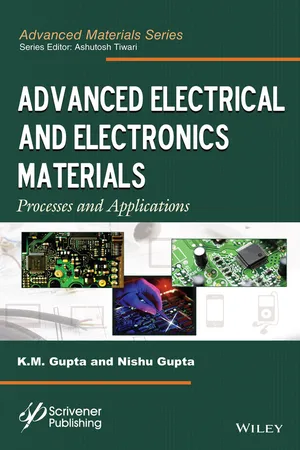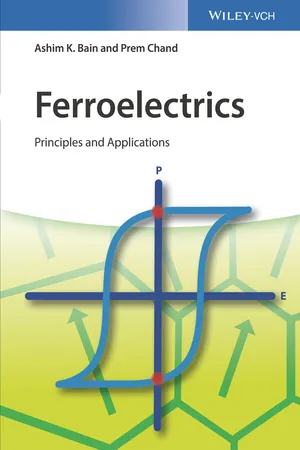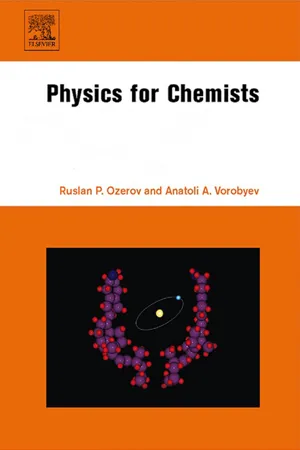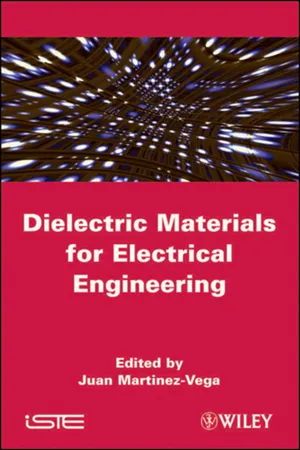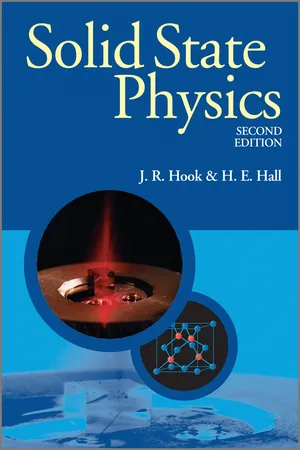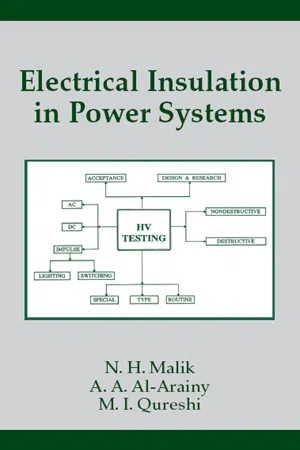Physics
Dielectric
A dielectric is a non-conductive material that can support an electric field and become polarized when subjected to an electric field. This polarization results in the storage of electrical energy within the dielectric. Dielectrics are commonly used in capacitors and insulating materials to prevent the flow of electric current.
Written by Perlego with AI-assistance
Related key terms
Related key terms
1 of 4
Related key terms
1 of 3
11 Key excerpts on "Dielectric"
- eBook - ePub
Advanced Electrical and Electronics Materials
Processes and Applications
- K. M. Gupta, Nishu Gupta, Ashutosh Tiwari(Authors)
- 2015(Publication Date)
- Wiley-Scrivener(Publisher)
Chapter 9Dielectric Materials: Properties and Behaviour9.1 Introduction to Dielectric Materials
We have described in chapter 4 that the solids having an energy gap of 3 eV or more are termed as insulators. In such materials it is almost impossible to excite the electrons from the valence band to the conduction band by means of an applied electric field or normal thermal energy. Insulators, also known as Dielectrics, are therefore very poor conductors of heat and electricity. However, they allow movement of some electrons at abnormally high temperatures causing a small flow of current.- Dielectrics are characterized by their
- high specific resistance,
- negative temperature coefficient of resistance, and
- large insulation resistance.
- The insulation resistance is affected by
- moisture,
- temperature,
- applied electric field, and
- age of Dielectrics.
- Dielectric materials may be
- solid,
- liquid, and
- gas.
In solid form they may be polymeric such as nylon, pvc, bakelite, polyethylene and wood, or may belong to the ceramic family such as glass, silica, mica, porcelain and steatite etc. A detailed classification is given in the next article.Uses. Dielectric materials are used in- electrical insulation,
- as capacitors,
- in strain gauges and
- sonar devices etc.
- eBook - ePub
Essentials of Physics Series
From the Material Properties of Solids to Nanotechnologies
- David Schmool(Author)
- 2016(Publication Date)
- Mercury Learning and Information(Publisher)
In general, Dielectric materials are insulating substances in which there are few or no free charge carriers and typically some form of ceramic or polymer. This means that an applied electric field can penetrate a significant distance into the their crystals. While we have discussed the importance of the electronic properties of materials in previous chapters, we also need insulating materials to prevent the passage of electrical current in regions where we do not want it to flow. The insulating coatings on wires and cables are an important application of Dielectric, for instance. The use of Dielectrics is also a crucial component in the construction of capacitors, where the static Dielectric properties of the material between the electric plates are an essential part of the capacitors ability to store charge.The fact that Dielectric materials have no free carriers can also be viewed as it having a large enough band gap to prevent the excitation, via thermal ionization, of electron - hole pairs. The optical properties of solids is intimately related to the existence or not of free charge carriers in the material. In the case of a material with many free charge carriers such as electrons, the interaction of the electric field with the electrons causes the mirror like appearance that most metallic substance have. This is due to the excitation and re-emission of radiation below the skin depth of the material. Actually the response in strongly frequency dependent. In the case of an insulating material, the penetration of light can go much further into the solid and many Dielectric materials are indeed transparent. The behavior can be evaluated from the frequency-dependent Dielectric constant, or in an equivalent manner, the refractive index of the material; - eBook - ePub
Ferroelectrics
Principles and Applications
- Ashim Kumar Bain, Prem Chand(Authors)
- 2017(Publication Date)
- Wiley-VCH(Publisher)
A Dielectric material is a substance that is a poor conductor of electricity. On the basis of band structure, the Dielectric materials have an energy gap of 3 eV or more. This large magnitude of energy gap precludes the possibility of electrons being excited from the valence band to the conduction band by thermal means. A Dielectric is an electrical insulator that can be polarized by an applied electric field. When a Dielectric is placed in an electric field, electric charges slightly shift from their average equilibrium positions, causing Dielectric polarization. Because of Dielectric polarization, positive charges are displaced toward the field and negative charges shift in the opposite direction. This creates an internal electric field that reduces the overall field within the Dielectric itself. If a Dielectric is composed of weakly bonded molecules, those molecules not only become polarized but also reorient so that their symmetry axis aligns to the field. The ideal Dielectric material does not exhibit electrical conductivity when an electric field is applied. In practice, all Dielectrics do exhibit some conductivity, which generally increases with increase in temperature and applied field.The study of Dielectric properties is concerned with the storage and dissipation of electric and magnetic energy in materials. In practice, most Dielectric materials are solid. Examples include porcelain (ceramic), mica, glass, plastics, and the oxides of various metals. Dielectrics are employed as insulation for wires, cables, and electrical equipment, as polarizable media for capacitors, in apparatus used for the propagation or reflection of electromagnetic waves, and for a variety of artifacts, such as rectifiers and semiconductor devices, piezoelectric transducers, Dielectric amplifiers, and memory elements.Some liquids and gases can serve as good Dielectric materials. Dry air is an excellent Dielectric and is used in variable capacitors. Distilled water is a fair Dielectric. A vacuum is an exceptionally efficient Dielectric. Many of the traditional industrial Dielectric materials are still in common use, and they compete well in some applications with newer materials regarding their electrical and mechanical properties, reliability, and cost. For example, oil-impregnated paper is still used for high-voltage cables. Various types of pressboard and mica, often as components of composite materials, are also in use. Elastomers and press-molded resins are also of considerable industrial significance. However, synthetic polymers such as polyethylene, polypropylene, polystyrene, polytetrafluoroethylene, polyvinyl chloride, polymethyl methacrylate, polyamide, and polyimide have become important, as has polycarbonate because it can be fabricated into very thin films. Generally, polymers have crystalline and amorphous regions, increasing crystallinity, causing increased density, hardness, and resistance to chemical attack but often producing brittleness. Many commercial plastics are amorphous copolymers, and often additives are incorporated in polymers to achieve certain characteristics or to improve their workability. - eBook - ePub
Materials
Engineering, Science, Processing and Design
- Michael F. Ashby, Hugh Shercliff, David Cebon(Authors)
- 2009(Publication Date)
- Butterworth-Heinemann(Publisher)
York Minster, constructed between 1220 and 1400, is one of the great cathedrals of Europe. Many fine sermons have been preached from its pulpit, but in 1984, when the Archbishop of York expressed his disbelief in the Virgin Birth, the Minster was struck by lightning and severely damaged. Some put this down to the wrath of God, but the reality is simpler: the cathedral was inadequately earthed. There is a message here: even when you are designing cathedrals, electrical properties matter.This chapter is about the simplest of these: they relate to conduction, insulation and Dielectric behaviour. Electrical conduction (as in lightning conductors) and insulation (as in electric plug casings) are familiar properties. Dielectric behaviour may be less so. A Dielectric is an insulator. It is usual to use the word ‘insulator’ when referring to its inability to conduct electricity, and to use ‘Dielectric’ when referring to its behaviour in an electric field. Three properties are of importance here. The first, the Dielectric constant (or relative permittivity ), has to do with the way the material acquires a dipole moment (it polarises ) in an electric field. The second, the Dielectric loss factor , measures the energy dissipated when radio-frequency waves pass through a material, the energy appearing as heat (the principle of microwave cooking). The third is the Dielectric breakdown potential , and this takes us back to York Minster. Lightning is Dielectric breakdown, and it can be as damaging on a small scale—in a piece of electrical equipment, for example—as on a large one.There are many different kinds of electrical behaviour, all of them useful. Figure 14.1 gives an overview, with examples of materials and applications. The chapter introduces electrical properties and their physical origins, and examples of design for electrical performance.Figure 14.1 The hierarchy of electrical behaviour. The interesting ones are boxed in red, with examples of materials and applications. Their nature and origins are described in this chapter.14.2 Conductors, insulators and Dielectrics
Resistivity and conductivity
The electrical resistance R (units: ohms1 , symbol Ω) of a rod of material is the potential drop V (volts2 ) across it, divided by the current i (amps3 ) passing through it, as in Figure 14.2 . This relationship is Ohm’s law:Figure 14.2 Electrical resistivity, ρ e . Its value ranges from 1 to 1024 µ - eBook - ePub
- Ruslan P. Ozerov, Anatoli A. Vorobyev(Authors)
- 2007(Publication Date)
- Elsevier Science(Publisher)
4Dielectric Properties of Substances
Publisher Summary
From the point of view of electric properties, all substances can be divided into two main classes—conducting and nonconducting an electric current. Metals, their alloys, and a small number of chemical compounds with metal character of interatomic interactions relate to the class of conductors. The second class includes other substances and represents the overwhelming majority. Conductivity is defined by the presence of free charge carriers in a substance; their absence determines Dielectric properties. So, Dielectrics are substances in which there are no free charges capable of covering long distances in the substance. Depending on their molecular structure, all Dielectrics can, in turn, be divided into two large groups—polar and nonpolar. In polar Dielectrics, molecules themselves represent the electric dipoles with the electric moment; it appears due to displacements of electric charges from positions of their equilibrium in free atoms as a result of chemical bonding. The molecular dipoles of polar Dielectrics participate in thermal motion; this can be translational motion (in gases and liquids), oscillation about equilibrium positions (solids and liquids) and rotation around the center of mass. As a result, the dipole electric moments are chaotically distributed along directions.Electric and magnetic interactions play an enormous role in chemistry and chemical technology; they govern the processes taking place in atoms and molecules, crystals, electrolysis, surfaces of solids electrolyzing of Dielectric polymer materials and others. Because the electric field in molecular systems has a very complex structure, for the convenience of the reader, we will give the nomenclature of electric fields at the beginning of the chapter. - eBook - ePub
- Juan Martinez-Vega(Author)
- 2013(Publication Date)
- Wiley-ISTE(Publisher)
ART 1General Physics PhenomenaPassage contains an image
Chapter 1
Physics of Dielectrics 1
1.1. Definitions
A Dielectric material is a more or less insulating material (with high resistivity and with a band gap of a few eV), that is polarizable, i.e. in which electrostatic dipoles exist or form under the influence of an electric field.Like any material, it is an assembly of ions with positive and negative charges which balance, for a supposedly perfect solid, so as to ensure electrical neutrality. This neutrality is observed at the scale of the elementary structural motifs which constitute solids with ionocovalent bonding (ceramics, for example) and on the molecular scale in molecular solids (polymers and organic solids).The action of an electric field at the level of these element constituent of solids manifests itself by Dielectric polarization effects. Let us remember that the dipole moment of a charge q with respect to a fixed system of reference centered in O is:[1.1]where is the vector which connects the point O to the charge’s position.If due to a force (caused, for example, by a magnetic field), the charge moves , then the variation of the moment will be:[1.2]represents the polarization effect of the field on the charge. The generalization of expressions [1.1 ] and [1.2 ] to a collection of charges occurs by vectorial summation of the moments of each charge. An important case is that of a set of two charges ±q, whose positions are defined by and (see Figure 1.1 ). The application of [1.1 ] to the two charges gives:Setting , we get:[1.3]is called the dipole moment formed by the two charges, oriented from the negative charge to the positive charge (see Figure1.1 ).The dipole moment appearing in a solid, during the application of a field - eBook - ePub
- J. R. Hook, H. E. Hall(Authors)
- 2013(Publication Date)
- Wiley(Publisher)
CHAPTER 9
Electric properties of insulators
There is no plea which will justify the use of high tension and alternating currents, either in a scientific or a commercial sense. They are employed solely to reduce investment in copper wire and real estate.—Thomas Edision (1889)9.1 DielectricS
9.1.1 Dielectric constant and susceptibility
Dielectric materials are electrical insulators † for which the response to a weak static or low-frequency electric field is given by(9.1)where P is the electric polarization (dipole moment per unit volume) and E is conventionally the macroscopic electric field inside the material (see appendix B for a discussion of the electric fields in matter). Comparison with Eq. (7.1) shows that Dielectrics are analogous to diamagnets and paramagnets; however, as the dimensionless static susceptibility χ is always positive for Dielectrics, it would be more consistent with magnetism if they were called paraelectrics. Pyroelectric materials (of which ferroelectric materials are a subset) possess a spontaneous electric polarization in the absence of an applied field; we discuss them further in section 9.2The electric susceptibility of a Dielectric is normally much larger than the magnetic susceptibility and is typically of order unity or larger at room temperature. Eq. (9.1) defines the SI susceptibility; as in the magnetic case, the reader is likely to encounter tabulations of cgs susceptibilities related by (Eq. (7.2) )We consider only Dielectrics for which P and E are parallel so that χ is a scalar quantity; crystals of cubic symmetry possess this property. The relative permittivity (Dielectric constant) ε is related to the susceptibility by(9.2)A theoretical value for the susceptibility can be obtained by first calculating the dipole moment of an isolated atom(9.3)produced by an applied field E; α is known as the polarizability of the atom. If the behaviour of atoms is not greatly affected by their incorporation in a solid then the polarization of the solid is obtained by summing Eq. (9.3) over the N - eBook - ePub
- Anupam Garg(Author)
- 2012(Publication Date)
- Princeton University Press(Publisher)
15 Electrostatics of Dielectrics94 The Dielectric constant
Nonconducting materials, also known as insulators or Dielectrics, differ from conductors in that (i) any free (mobile) charge must be externally supplied, and (ii) electric fields can penetrate inside them. For electrostatics, the macroscopic equations to be solved are Gauss’s lawand the law that the electric field is irrotational,As discussed in chapter 13 , to solve eqs. (94.1) and (94.2) one needs a constitutive relation connecting D and E , or, equivalently, a knowledge of P. 1 For most materials, it is found that D is linear in E , at least for low enough electric fields. The reason is exactly the same as that behind the concept of polarizability (section 89): at low fields, the induced dipole moments are linear in E , so P is linear in E. For isotropic materials, we write2The quantity (in Gaussian units), or / 0 (in SI), is known as the Dielectric constant of the material.3 It is a dimensionless number with the same value in both systems. For anisotropic systems, such as solid or liquid crystals, a linear relationship must, in general, be tensorial:where ij are the components of the Dielectric tensor. In the special case of cubic crystals, the tensor is isotropic, ij =δij, so one is back to eq. (94.3). Hence, such crystals behave like isotropic materials in their Dielectric properties.At the risk of being tiresome, we repeat that while eq. (94.3) is valid for a large variety of matter, it is not a fundamental law. Also, it holds only if the field E is small enough. We gave examples of the range of validity in chapter 13 - eBook - ePub
- Sivaji Chakravorti(Author)
- 2017(Publication Date)
- CRC Press(Publisher)
5Dielectric Polarization
ABSTRACT Contrary to conductors in which the charges are free to move anywhere within the material, in Dielectrics, all the charges are attached to specific atoms or molecules. However, these bound charges could be displaced by a small amount under the action of an external electric field. Many Dielectric materials have permanent dipoles that get aligned in the direction of the external electric field more and more as the strength of the external electric field is increased. The cumulative effect of such displacements of charges and/or alignments of dipoles determines the characteristics of Dielectric materials. This chapter discusses the mechanisms by which a Dielectric material gets polarized, that is, a Dielectric material acquires a net dipole moment when influenced by an external electric field. The properties of Dielectric materials that are intricately related to polarization are also discussed. Although a lot of Dielectric materials are linear, isotropic and homogeneous (LIH), not all Dielectrics exhibit such characteristics. Hence, Dielectric properties of anisotropic materials are dealt elaborately in this chapter. Frequency dependence of Dielectric polarization is also touched on.5.1 Introduction
Inside any material, the electric field varies rapidly with distance in a scale corresponding to the spacing between the atoms or molecules. The local electric field at the site of an atom is significantly different from the macroscopic electric field. It is because of the fact that the local electric field acting on an atom is strongly affected by the nearest atoms, while the macroscopic field is averaged over a large number of atoms or molecules. Therefore, the determination of electric field is extremely complicated, if not impossible, at every mathematical point - eBook - ePub
- N.H. Malik, A. A. Al-Arainy, M.I. Qureshi(Authors)
- 2018(Publication Date)
- CRC Press(Publisher)
δ are the characteristics of an insulating material pertaining to its molecular and atomic structure, which play a significant role in its power loss. Before considering this Dielectric loss, some basic concepts will be reviewed here.6.3.1. Electric PolarizationLet us consider a parallel plate capacitor having surface charge density q on its opposite plates of area A and separation d, then the resultant electric field Eo in vacuum is:E o= 4 π q(6.2) If we insert a Dielectric material of permittivity s between the plates, it will cause a decrease in the electric field intensity between the plates having a fixed surface charge density. This is because the Dielectric material tends to neutralize the charges at the electrode surface due to the formation of dipole chains of the molecules, as shown in Figure 6.6 . This phenomenon is called Dielectric polarization (P). The charge density in this case becomes Eo /4πε, where ε = εo εr . HenceP =−E o4 πE o4 π εP =(ε − 1)E4 π(6.3) These equations provide a direct relationship between P, ε and E, and emphasize that polarization is increased with permittivity and applied stress.6.3.2 Polarizability of MoleculesIn the absence of applied electric field, the net charge on molecules of a Dielectric material is zero. But on the application of external field, the electrons are slightly displaced with respect to the nuclei; induced dipole moments result and cause the so-called electronic polarization of materials. For example, if in a neutral H2 atom the charge of an electron and that of a proton are displaced distance d, then it results as a net-induced dipole moment, μ = ed, where e is the charge of electron. The resultant dipole moment due to electrons in an insulating material can therefore be expressed as:μ =α eE(6.4) Figure 6.6 Electric polarization in a Dielectric.where αe is the electron polarizability of atoms, which depends on E. For all materials, the value of αe - eBook - ePub
- Michael M. Mansfield, Colm O'Sullivan(Authors)
- 2020(Publication Date)
- Wiley(Publisher)
Dielectric material.A cylindrically shaped volume element in an insulator. When an electric field is directed along the axis (the axis), positive charge is displaced in the direction of the field and negative charge in the opposite direction thus forming an electric dipole.Figure 17.4The net electric field strength E at a point in a Dielectric specimen can be considered to be the result of the contributions from two independent sources, namely (i) the electric field strength at the point in the absence of the Dielectric material, that is , and (ii) an additional electric field strength Epol arising from the polarization of the material, that isIn Dielectric materialsEpolopposesE0and thus the magnitude of the electric field strength at any point within the specimen is less than that which would be observed in the absence of the specimen that iswithIf the cylindrical volume element in Figure 17.4 is sufficiently small that the electric field inside the element may be considered uniform, the distribution of charge within the element may be considered to arise from two uniformly charged discs with equal and opposite charge at each end of the cylinder (Figure 17.5 ). From a macroscopic perspective such charges are ‘fictitious’1 in that they do not contribute to electric flux (they are cancelled by the opposite charge on the end face of the adjacent element). Nevertheless, for the purpose of determining the contribution to the electric field due to polarization, such charges can be treated as the source of Epol .The cylindrically shaped volume element in Figure 17.4Figure 17.5
Index pages curate the most relevant extracts from our library of academic textbooks. They’ve been created using an in-house natural language model (NLM), each adding context and meaning to key research topics.
Explore more topic indexes
Explore more topic indexes
1 of 6
Explore more topic indexes
1 of 4
